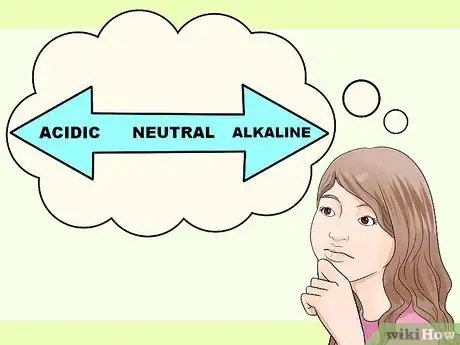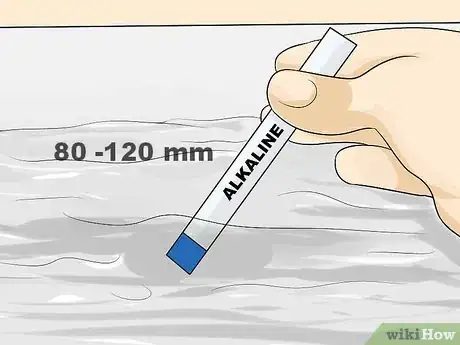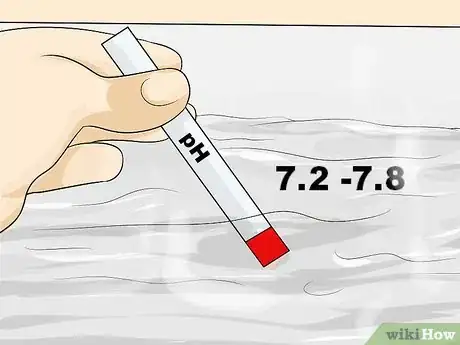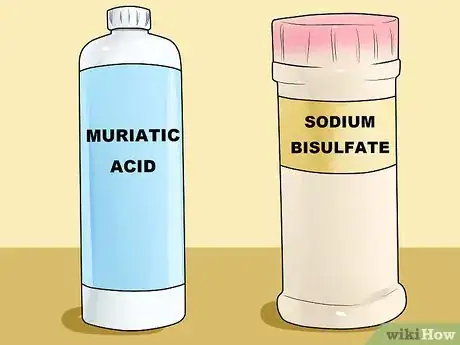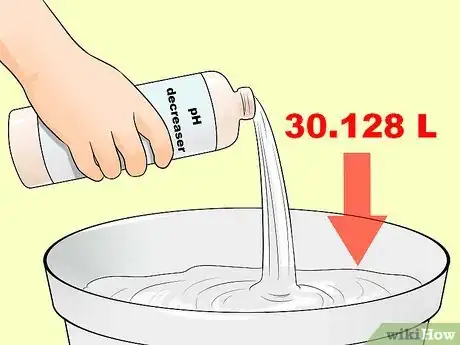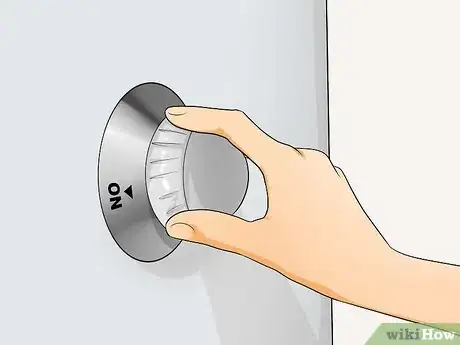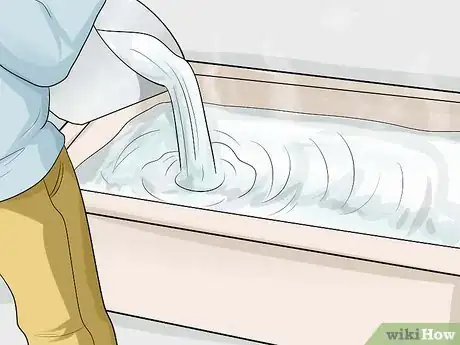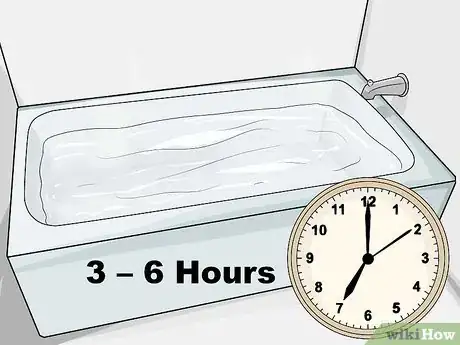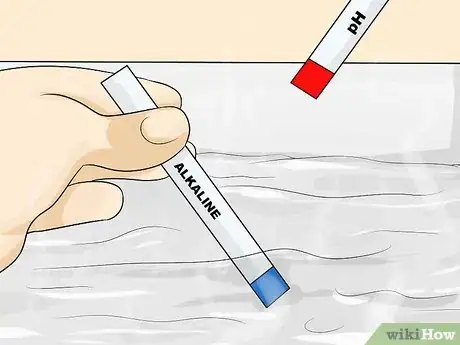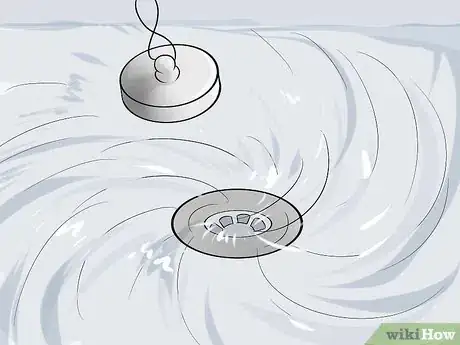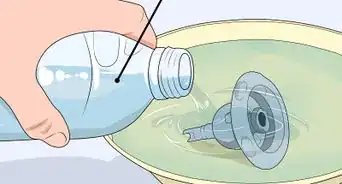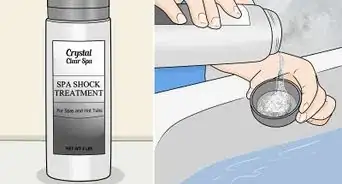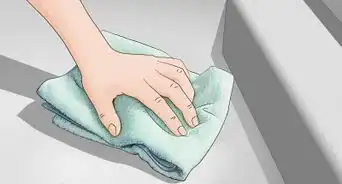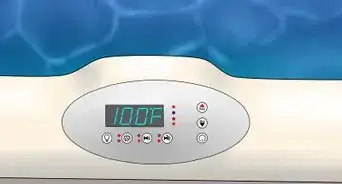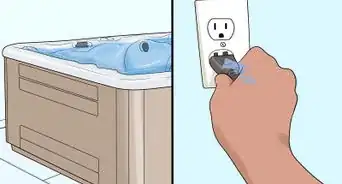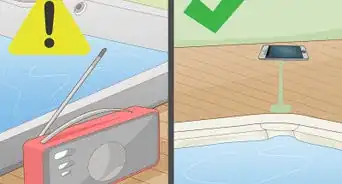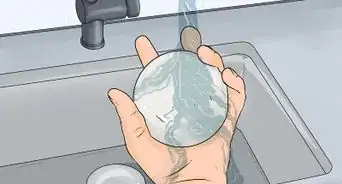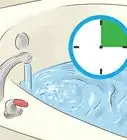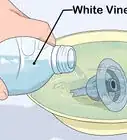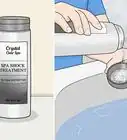wikiHow is a “wiki,” similar to Wikipedia, which means that many of our articles are co-written by multiple authors. To create this article, 9 people, some anonymous, worked to edit and improve it over time.
There are 7 references cited in this article, which can be found at the bottom of the page.
This article has been viewed 306,266 times.
Learn more...
When the water in a hot tub becomes too alkaline, its pH increases, and the condition of the water deteriorates significantly. The total alkalinity of the water will probably be high at this point, as well. To lower the pH in a hot tub, you need to add a pool acid capable of dropping both the pH and total alkalinity.
Steps
Testing the Water
-
1Understand the relationship between pH and total alkalinity. The pH of the water is essentially a measure of the level of acidity in the water. Total alkalinity is a measure of the water's ability to buffer and resist changes to the pH.[1]
- More precisely, pH is a measure of the concentration of hydrogen ions in the water. Fewer hydrogen ions will cause the pH to spike.
- Total alkalinity's ability to measure the water's resistance is more accurately described as a measurement of "buffering capacity."
- When the alkalinity of the water becomes high or low, the pH will follow shortly after.
- Since the two are so closely connected, you will often need to correct both at the same time.
-
2Know the signs of high alkalinity and high pH. You can usually tell when the pH and alkalinity of your hot tub are high based on the way it runs.[2]
- When the alkalinity and pH get too high, chlorine-based disinfectants are less effective. As a result, the water quality deteriorates, causing build-up and other problems in the hot tub.
- Signs of high alkalinity include the formation of scales along the sides and bottom of the tub, cloudy water, skin irritation, eye irritation, and poor sanitary conditions.
- Similarly, signs of high pH also include poor sanitary conditions, cloudy water, the formation of scales, skin irritation, and eye irritation. The lifespan of the hot tub's filter will also decrease.
- Note that if you see corrosion, etched plaster, or stained plaster, the pH and alkalinity are probably too low. Rapid changes in he pH are often symptomatic of low alkalinity, as well.
Advertisement -
3Test the total alkalinity of the hot tub. Even if you suspect that the alkalinity of your hot tub water is high, you should confirm your suspicions by testing the water with an alkalinity testing strip or kit.[3]
- An ideal range for alkalinity is between 80 and 120 ppm.
- Total alkalinity should be tested before the pH.
-
4Test the pH of the hot tub. Similarly, even if you suspect that the pH of the water is high, you should take a precise measurement of the actual pH by testing the water with a pH testing kit or testing strips.[4]
- The ideal pH range for hot tub water is between 7.4 and 7.6, but the acceptable range is between 7.2 and 7.8.
- If the water pH is higher than this ideal range, the water is too basic or alkaline.
Lowering the pH
-
1Choose the right chemical. To lower both total alkalinity and pH, you will need to add an acid. Liquid muriatic acid (hydrochloric acid diluted to 20 percent) and dry sodium bisulfate are among the most popular choices.[5]
- The acid combines with the water, thereby increasing the concentration of hydrogen ions and lowering the pH.
- Similarly, the acid reacts with bicarbonates in the water and reduces the water's total alkalinity in the process.
- You could also look for a generic “pH decreaser,” “alkalinity decreaser,” or “combination decreaser” chemical at a pool supply store.
-
2Determine your initial measurements based on total alkalinity. The pH will drop faster than the alkalinity, so you need to fix the alkalinity first. Once you balance the alkalinity, the pH will gradually adjust to it.[6]
- Always follow the instructions on your pH/alkalinity chemical when preparing the correct amount.
- As a general rule, you will need 1.6 lbs (725.75 g) sodium bisulfate or 1.3 qt (1.23 L) muriatic acid for every 10,000 gallons (37.85 kL) of water to drop the total alkalinity by 10 ppm.
-
3Mix the chemical together with a small amount of water. Scoop water out of your hot tub into an 8 gal (30.28 L) plastic bucket until that container is three-quarters full. Pour the full amount of pH decreaser into the water in the bucket and let it dissolve.[7]
- You must add the acid to the water. Pouring the acid into the bucket first and adding the water can cause damage to the bucket and may result in ineffective mixing.
-
4Turn the hot tub on. Make sure that the pump and filters are running. The hot tub should be set at its usual temperature and speed before you continue.[8]
- It is crucial, however, that no one is in the hot tub while you are balancing the water.
-
5Add the diluted chemical to the hot tub. Slowly pour the diluted decreaser into the center of the hot tub.[9]
- Pour the acid in gradually instead of dumping it in all at once. Adding the acid too quickly can cause damage to the sides, bottom, and equipment in the hot tub.
-
6Give the water a chance to balance. Allow the pump to circulate the water for three to six hours after you add the decreaser.[10]
- During this time, the pumps should circulate the water and acid together more thoroughly. Only after the two have been well combined will the pH and alkalinity be consistent throughout the hot tub, and you need to wait until these measurements are consistent before moving on any further.
-
7Test the alkalinity and pH again. Test the alkalinity first, then the pH.
- If done correctly, the alkalinity should already be balanced. The pH may not be balanced yet, however.
- If either the alkalinity or pH is still high, repeat the process. Continue as needed until the water is well balanced.
-
8Periodically drain the water. You should completely drain the water in your hot tub at least once every four to six months. Afterward, fill the hot tub back up, balance the pH and alkalinity as needed, and continue to monitor the conditions as usual.[11]
- You will need to balance the pH and alkalinity of your water nearly every week if you use the hot tub regularly. Adding chemicals to the water so often can cause excess build-up, and you will likely notice that it is becoming more difficult to balance your water conditions.
- Once you notice this difficulty, it is time for you to change the old water out for fresh water.
Community Q&A
-
QuestionMy pH is orange, does this mean it is high or low?
 Konner WilsonCommunity AnswerYour pH is low. This is slightly acidic, probably a 3-4 on the scale. Remember, green is neutral.
Konner WilsonCommunity AnswerYour pH is low. This is slightly acidic, probably a 3-4 on the scale. Remember, green is neutral. -
QuestionOur hot tub's pH is too high, but the alkalinity is normal. We're using a pH decreasing product, but it still won't go down. How can we fix this?
 Community AnswerTake a sample into your local pool retailer and have it analyzed. If your pH is high and adding pH decreaser has no effect, you could have what is known as pH lock. Have your source water analyzed to determine initial levels.
Community AnswerTake a sample into your local pool retailer and have it analyzed. If your pH is high and adding pH decreaser has no effect, you could have what is known as pH lock. Have your source water analyzed to determine initial levels. -
QuestionCan itchy skin with a rash be caused by a pH imbalance in our spa?
 Community AnswerThe short answer is yes. The pH level can irritate your skin. The warm water will dilate your pores and the water will also rinse away any protective natural oils. If the condition is paired with a low sanitizer level, it creates an ideal path for bacteria to enter your skin and cause an infection.
Community AnswerThe short answer is yes. The pH level can irritate your skin. The warm water will dilate your pores and the water will also rinse away any protective natural oils. If the condition is paired with a low sanitizer level, it creates an ideal path for bacteria to enter your skin and cause an infection.
Warnings
- Wear gloves as you handle any pool acid. Never touch the acid with your hands or with any bare skin.⧼thumbs_response⧽
- You should also consider wearing safety goggles. Otherwise, the acid may splash into your eyes when you add it to the hot tub.⧼thumbs_response⧽
- Handle pool acid with extreme care. The acid can cause irritation, burns, and temporary/permanent blindness under the worst conditions.⧼thumbs_response⧽
Things You'll Need
- pH tester
- Total alkalinity tester
- Large plastic bucket
- Rubber gloves
- Safety goggles
- Pool, spa, and hot tub acid (muriatic acid, sodium bisulfite, or chemical decreaser product)
References
- ↑ https://blog.orendatech.com/total-alkalinity-role-water-chemistry
- ↑ http://www.spacare.com/understandingspaandhottubwaterchemistry.aspx
- ↑ https://spacare.com/understandingspaandhottubwaterchemistry.aspx
- ↑ https://spacare.com/understandingspaandhottubwaterchemistry.aspx
- ↑ https://www.youtube.com/watch?v=HN11nOOCvG4
- ↑ http://www.poolxperts.org/ph-level-in-hot-tub/
- ↑ https://www.swimuniversity.com/muriatic-acid/
- ↑ http://www.poolxperts.org/ph-level-in-hot-tub/
- ↑ http://www.poolxperts.org/ph-level-in-hot-tub/
About This Article
To lower the pH in a hot tub, you can add liquid muriatic acid to the water to reduce the total alkalinity. Alternatively, you can use dry sodium bisulfate. Either acid will work. Whichever acid you decide to use, you’ll need to dilute it with water first according to the directions on the packaging. Then, just turn on your hot tub, pour the mixture into the water, and let it circulate. When you're done, use a pH test kit to check the new pH levels in the water. To learn how to recognize high alkalinity and high pH in a hot tub, keep reading!
